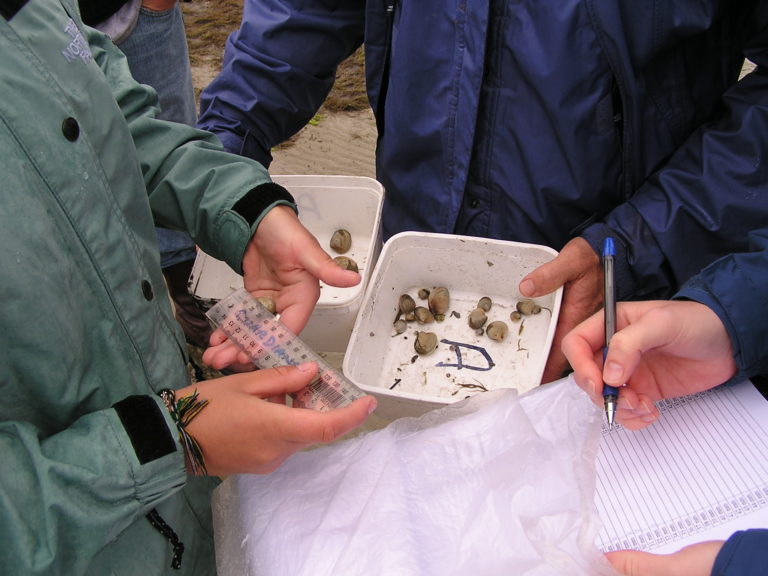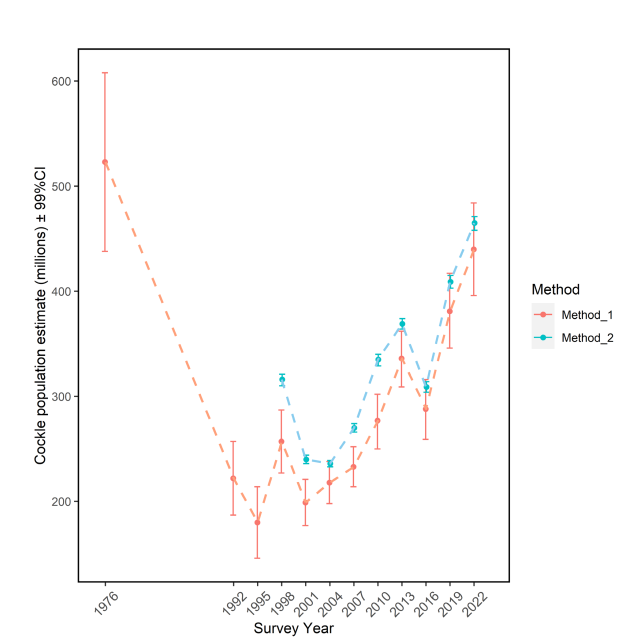Cockle Surveys
ADVANCED NOTICE: The next Cockle Survey will take place this November.
We will keep you posted when preparation is underway
The cockle, a filter-feeding bivalve mollusc, is a robust keystone species of sheltered coastal habitats and an indicator species of ecosystem health. A significant and long-term decrease in the abundance and size distribution of cockles is likely to represent changes to environmental factors that affect the ecology of the habitat with probable loss of ecosystem function.
In Pāuatahanui Inlet, cockles are present in huge numbers and it is estimated that together they filter at least a quarter of the volume of seawater with each incoming tide. Understanding the trend in population is therefore a very helpful indicator of the state of the marine environment in the Inlet.
A Cockle Survey or Cockle Count is a scientifically-based method of establishing an estimate for the number of cockles to be found. It involves teams of people sampling the intertidal regions of the shoreline to pick out live cockles from a large number of randomly selected small square patches of sediment and measuring the size distribution, i.e. how many of each size are found in each sample. The results are then analysed and extrapolated to produce an estimate of the total number of cockles present in the whole Inlet.

History of the Surveys
The Guardians of Pāuatahanui Inlet have carried out 11 (eleven) triennial surveys of the intertidal cockles (Austrovenus stutchburyi) in Pāuatahanui Inlet since 1992. These surveys now provide an important time-series data-set to monitor trends in cockle population densities, and their sizes, over space and time, in the intertidal zone.
The first systematic sampling of the cockles in the Inlet was undertaken in 1976 by the then New Zealand Oceanographic Institute of the DSIR (Department of Science and Industrial Research). It was conducted as part of the wider Pāuatahanui Inlet environmental study, coordinated by W.B. Healy and published as a book in 1980.
Since 1992 GOPI, with the assistance of other community volunteers, have undertaken regular triennial surveys of the cockle population at a representative selection of sites around the shores of the Inlet with overall oversight by NIWA (National Institute of Water and Atmospheric Research). NIWA then analyses and reports on the findings. These surveys were specifically designed to be conducted by members of the general public, with supervision by members of GOPI and other experienced team leaders.
The first survey in 1992 found there had been a significant decrease in the population since 1976. The second, in 1995, showed that the decline had continued, albeit at a slower rate. Potential causes of such decline include increased sedimentation, poor or insufficient nutrients, and increased harvesting pressure. Since then, however, the population has increased survey-on-survey, with just one exception in 2016.
The relatively stable population size of cockles in the period between 1992 and 2010, and the relatively high proportion of juveniles in following surveys, suggested that the intertidal habitats of Pāuatahanui Inlet had not changed greatly over this period. Since then, the population has been increasing significantly.
The survey in 2019 showed a marked jump in population size, recovering from the decline in 2016, indicating the population of cockles in the intertidal zone of Pāuatahanui Inlet is in an improving state. The consistently high percentages of juvenile cockles since 2004 (12.4–17.4% of the total populations) suggests successful settlement of larvae and good survival of spat, or the immigration of juvenile cockles from subtidal areas. High percentages of cockles (more than 50%) are above spawning size (larger than 18 mm in length) and that should maintain larval production in the Pāuatahanui Inlet for the foreseeable future.
The latest survey, in 2022, has shown that the population of cockles is still increasing despite concerns over the ongoing deterioration of the Inlet health. See below.

Estimates of total cockle population size and 99% confidence intervals for Pāuatahanui Inlet, 1976–2022.
The initial survey in 1976 (Richardson et al. 1979) used a different survey design from that of GOPI (Method 1). Surveys since 1992, carried out by the Guardians of Pāuatahanui Inlet, have all used an alternative survey design and method (Method 2).
Estimates using the Method 1 are shown in pink and estimates using weighting factors for transect length, Method 2, are shown in blue.
Trends in population size are shown as dashed lines.
By 2004 these regular surveys had reached a significant milestone when they were then thought to be the longest running and most comprehensive community science project in New Zealand. By now, in 2023, this has become an accepted accolade.
Current Status - The 2022 Survey
The most recent survey, the eleventh in the series, was conducted in November 2022. NIWA has analysed the raw data from this survey and on 16 June 2023 released the finalised report on the status of cockles in the Inlet. The above chart is from this latest report.
To summarise the report the 2022 survey shows that:
• The estimated mean population of cockles in the Inlet as of 2022 is 440 million. This figure is the highest recorded estimate since 1992 representing an increase of 86.5% between 1992 and 2022. This estimate also is a figure representing 84% of that obtained from the first and highest population survey taken by the New Zealand Oceanographic Institute in 1974.
• Most transects in 2022 had higher or markedly higher total counts of cockles than in previous surveys.
• The highest number of cockles recorded per 0.1 m² quadrat in 2022 was 289, higher than in previous surveys.
• The mean cockle density over the intertidal survey area in 2022 was 44 cockles per 0.1 m², the highest since 1992.
• The percentage of juvenile cockles in the population increased markedly between 1992 and 2004 from 1% to 16% and has remained high, measuring 19.8% in 2022. The high percentage of juveniles since 2004, with the population increasing over this time, suggests regular recruitment and good survival of newly settled spat over their first winter.
From these results it can be inferred that there has been successful settlement of larvae and good survival of spat within the intertidal areas, or that there is potentially some immigration of juvenile cockles from subtidal areas.
The high percentages of cockles above spawning size (larger than 18 mm in length) should maintain larval production in the Pāuatahanui Inlet in future years.
It is important to note that this trend is not consistent with the expectation that there would be a relatively high mortality of small cockles after the 2016 floods. This event resulted in a short lived reduction in the cockle population found in the survey of that year, but recovery has been strong and continuous since then.
It is apparent that deteriorating environmental conditions in Pāuatahanui Inlet, particularly the increase in terrestrial sediments considered deleterious to cockles, do not appear to have affected the intertidal cockle population as a whole although some localised effects are evident in places.